Dude! Take Your Turn!
A Gaming Life
Boardgame Geek Top 100 – Played or Play? 60-51
With this post we’re half-way through the BGG Top 100 and I have to say that this has been a fun project for me. I hope you’ve enjoyed it as much as I have.
One thing going through this list does for me is show me just how few games I’ve actually played compared to a lot of people out there.
According to my BG Stats app (a must-have for anybody who actually tracks their plays), I’ve played a total of 383 games and that’s mostly true (I think there are a few games that I played before I started recording). When I think about most of the boardgame content creators out there and how many they’ve played, I kind of feel like a blogging pretender in a way.
That’s why I make my Top 10 “games I played that year” rather than “best games of the year”. I don’t have any way of knowing how the ones I’ve played compared to all of the other ones.
So it’s nice to just take a look at a bunch of games that may not get covered on this blog much.
Considering the response to this series, I’m having an understandable reaction.

Hell, I even got into a nice discussion with a brilliant game designer!
Anyway, this week is a good one with lots of stuff that I’ve actually played.
And I can’t wait!
Oh yeah, it’s right here below. I guess no waiting involved.
Let’s get started!
#60 – Underwater Cities (Rio Grande Games) – 2018
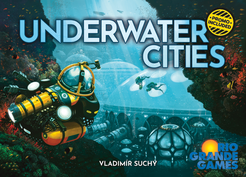
Designer: Vladimír Suchý
Artists: Uildrim, Milan Vavroň
Underwater Cities is another one of those games that I really want to play, but every other time it comes out either they have enough players already or I’m already tied up into something else.
But I really really want to play it.
It sounds so interesting and I have heard it compared favourably to Terraforming Mars so there is that. Whether that’s a legitimate comparison or not I’ll leave to those who have played it…which sadly isn’t me!
Yet.
Anyway, in the game each player is an expert who has been tasked with building the best city underneath the ocean due to overpopulation on the planet’s surface.
Let’s blurb this because it explains it better than I can (not having played it…have I mentioned I haven’t played it before?) and will make more sense than if I tried.
Plus it’s Saturday night when writing this entry, I’m not drunk but I’m lazy.
“The main principle of the game is card placement. Three colored cards are placed along the edge of the main board into 3 x 5 slots, which are also colored. Ideally players can place cards into slots of the same color. Then they can take both actions and advantages: the action depicted in the slot on the main board and also the advantage of the card. Actions and advantages can allow players to intake raw materials; to build and upgrade city domes, tunnels and production buildings such as farms, desalination devices and laboratories in their personal underwater area; to move their marker on the initiative track (which is important for player order in the next turn); to activate the player’s “A-cards”; and to collect cards, both special ones and basic ones that allow for better decision possibilities during gameplay.”
It sounds really intriguing.
Once we can get back to our regular game days, I really do want to finally get this played.
Because I haven’t.
Somehow, I think I’ve mentioned that before.
#59 – Clank! A Deck-Building Adventure (Renegade Game Studios/Dire Wolf Digital) – 2016

Designer: Paul Dennen
Artists: Rayph Beisner, Raul Ramos, Nate Storm
This one, however, I’ve played.
Only once, but I have played its sister game Clank in Space many times!
Clank is the fantasy version of the game, and the original one.
It also suffers a bit from the “run in, collect the cheapest artifact, and run out” way to end the game prematurely, which is one reason I don’t like it as much as its sister.
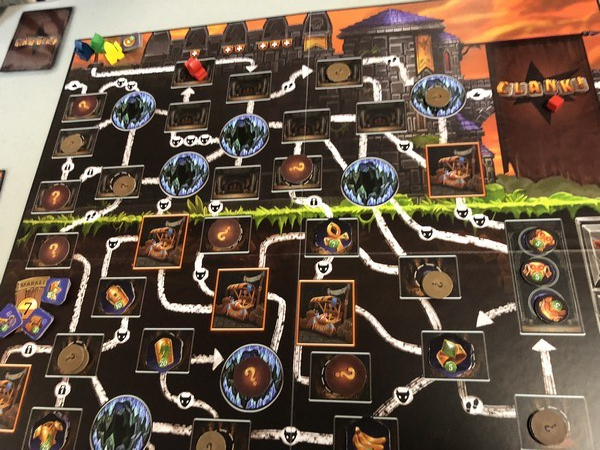
In Clank, players are delving deep into the dragon’s lair to steal a priceless artifact (though with each one worth a different amount of victory points, that doesn’t seem priceless!) from the dragon who’s currently sleeping.
These adventurers obviously aren’t Rogues because they couldn’t be quiet to save their lives. You will play the cards in your hand to either get the ability to buy more cards, to defeat monsters, or to move around the lair. Sometimes you’ll be collecting secrets, sometimes money, and finally you’ll reach one of the artifacts!
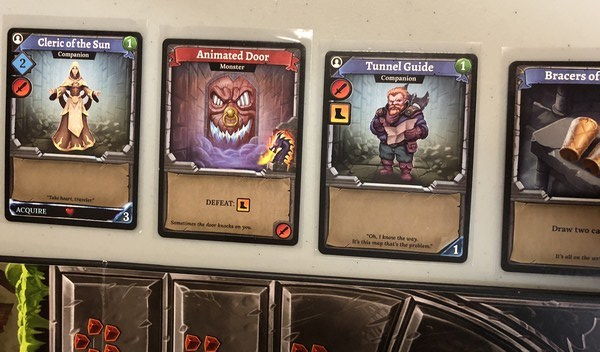
When certain cards with a dragon symbol come out into the purchase row, the Dragon awakes and goes on a rampage. When you make noise you’ll be putting clank cubes in the clank area, and when the dragon rages you’ll put all of that clank in a bag. You will then draw multiple cubes based on how angry the dragon is. If a player’s cube is drawn, that’s a wound.
Too many wounds and you’re dead.
If you die underground, you get no points (gee, I think I wrote something about that).
If you manage to get your artifact above ground, then you’ll still get all of your points but you won’t get the extra points for totally escaping.
I’m not as big of a fan of the fantasy clank for the grab & dash reason mentioned above, as well as the fact that it doesn’t have factions on its cards.
In Clank in Space, many cards have factions and if you combine them (play them on the same turn), you’ll get extra benefits.
That’s not the case in the original game.
However, it also takes about half the time (even when you don’t do the hit and run) so whether or not I would want to play this or the space one would also depend on that.
Plus the fact that I own Clank in Space but not this one.
I wouldn’t turn this one down in a pinch, though. I did really enjoy my one play, and I’d love to try with one or more of the expansions.
#58 – Caylus (Ystari Games) – 2005
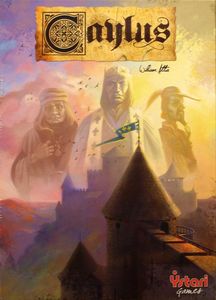
Designer: William Attia
Artists: Cyril Demaegd, Arnaud Demaegd, Mike Doyle
It’s almost fitting that this game and the next one are right next to each other on the BGG Top 100. Many a time that somebody mentions Lords of Waterdeep, it gets unfavourably compared to Caylus.
Which is too bad, because that one’s good too (though I’ll talk more in the next entry).
As for Caylus, I played the iOS app version many many eons ago but have never actually sat down at the table with it. The app has disappeared from the App Store so I don’t think I have access to it anymore.
This has been revised last year as Caylus 1303, which was supposed to shorten and streamline the game a bit.
If I ever end up getting this played, that will probably be the version that gets played because it’s the most available. However, it did actually come out at a game day a couple of years ago, but I was otherwise occupied.
The players are master builders who are attempting to build a new castle to strengthen the borders of France. Caylus starts out as a village, but with all of this construction going on, it’s soon to become a bustling city.
Current citizens will complain that all of these new people are coming in and wrecking the place.
Anyway, let’s blurb:
“Each turn, players pay to place their workers in various buildings in the village. These buildings allow players to gather resources or money, or to build or upgrade buildings with those resources. Players can also use their resources to help build the castle itself, earning points and favors from the king, which provide larger bonuses. Building a building provides some immediate points, and potentially income throughout the game, since players receive bonuses when others use their buildings. The buildings chosen by the players have a heavy impact on the course of the game, since they determine the actions that will be available to all the players.
As new buildings are built, they stretch along a road stretching away from the castle, and not all buildings can be used every turn. Players have some control over which buildings are active by paying to influence the movement of the Provost marker. The final position of the marker is the newest building that can be used that turn. The Provost marker also helps determine the movement of the Bailiff marker, which determines the end of the game. Generally, if players are building many buildings and the Provost is generous in allowing them to be used, the game ends more quickly.”
I have heard many people curse the Provost.
Anyway, this one has always been kind of intriguing to me but I heard it was pretty brutal.
Maybe that’s why they streamlined it?
I’d like to play it once, just to say that I did and make that comparison myself.
What comparison?
Oh, this one…
#57 – Lords of Waterdeep (Wizards of the Coast) – 2012
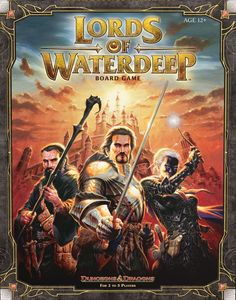
Designers: Peter Lee, Rodney Thompson
Artists: Tons!
Yes, another worker placement game where one of the things you’re doing is building buildings, though in this game you’re also sending out adventurers to fulfill quests that will give you the majority of your points.
I guess you could say that they are resources, though don’t try telling your wizards that or they’ll turn you into a newt.
Lords of Waterdeep is a game that I’ve played on the table a few times but have tons of plays of the app version on my iPad. I’m also pretty sure I played it at Dragonflight convention a few years ago but it’s not in my BG Stats app so I couldn’t tell you when that was.
It really is a cool game.
Sadly, my plays of it on the table are too far back for me to actually have pictures handy of them, but trust me it looks great.
Players are masked lords of the city of Waterdeep who are sending adventurers out to do various quests, as well as building buildings that may also gain victory points (depending on how long they’ve been available to build) or that will just help you (or other players) fulfill those quests all the faster.
The cool thing about the buildings is that if other players use their abilities and you are the one who built it, you will get some benefit too.
The game goes over 8 rounds where you will be putting your workers out on buildings (either on the board or ones that have built by players) and you will be working to fulfill quests by spending adventurers that you have recruited.
You may get more points at the end of the game depending on what types of quests you fulfill and what your lord likes to do.
After 8 rounds, total up the victory points (including the extra victory points based on your lord and what types of quests you like to do) and see who’s the winner!
I really enjoy this game, and I have tons of plays on the app.
Sure, some people don’t like that the adventurers are just cubes of different colours and others think it’s a bit too straightforward, but I really do like this one. You can always bling it up if you want to spring for actual adventurers.
I don’t mind the cubes and I think this is a nice worker placement game that, while it’s not flashy, is pretty straightforward and easy to teach.
I got my non-gamer wife to play it a couple of times and then on the app a few times, and that’s saying something.
Worker placement isn’t her genre of choice but she liked this one well enough.
It’s not an awesome game, but it’s very good.
I’ll definitely play it any time it comes up.
#56 – Five Tribes (Days of Wonder) – 2014
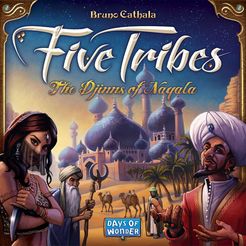
Designer: Bruno Cathala
Artist: Clément Masson
Five Tribes has a great mancala mechanic that has you picking up a bunch of workers on the same spot and then spreading them around on a path until you reach the space that you want to actually activate.

This isn’t that hard of a game, but it is fairly interesting because you have to plan your mancala out pretty well and make sure you can hit the spot that you want to hit with the meeple you want to hit it with. But even if you can’t, you can usually do something.
The workers aren’t necessarily yours, so you can choose whatever pile of workers you want to distribute, which is also pretty cool.
Also, you need to choose which workers will actually do what you want them to do, so maybe you don’t want to land that blue worker on the tiles if you want to do something else.
It’s a pretty simple game overall, but the strategy is where this game really comes into its own.
I really enjoyed my one play of this game, and I’d definitely like to play this one again. Sadly, the person in our game group who owns this one no longer comes to our game day so I probably won’t get it played again.
However, if I could, I would definitely try it.
#55 – The Gallerist (Eagle-Gryphon Games) – 2015

Designer: Vital Lacerda
Artist: Ian O’Toole
The Gallerist breaks my brain, but in a good way. There are so many cool things about this one, but all of it is so intricately connected that I never really manage to combo things so that I am able to do things in an efficient manner.
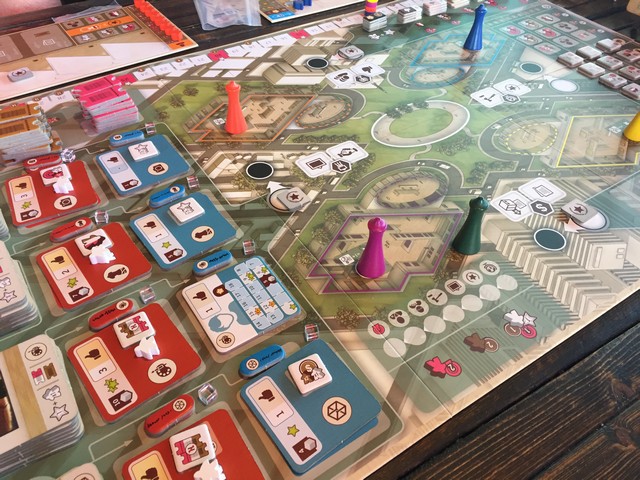
However, my two plays of this span two years (once at Shut Up & Sit Down last year and then once a year before that) and I really need to play this a couple of times in a row just to see if I can figure out what’s the best way to play this one.
In the game, you are heads of art galleries who are trying to find the next big artist and then grooming them to have their painting worth a bunch of money so you can sell them at a profit.
You’re finding artists, finding art, trying to publicize them and trying to make money. It’s all very intricate and hard to keep straight. My brain hurts just thinking about it.
But it’s so fun!
That’s why I need to play it a couple of times in a row. When I played at the Shut Up & Sit Down convention last year, it had been two years since I played it. I had no recollection of how to play it well and I truly sucked at it.
Lacerda games always make my head hurt, but they also are a blast to play. I really need to play this one again.
#54 – Dominant Species (GMT Games) – 2010

Designer: Chad Jensen (RIP 😦 )
Artists: Chad Jensen, Rodger B. MacGowan, Chechu Nieto, Eric Williams
I have heard so many great things about this game, and I actually did get to partially play this one on a long Saturday before everybody had to leave and we just called it.
Especially when, as many fans of the game say, you can’t really determine the winner until you play the whole thing because so much of it can happen at the end.
It was so long ago that I played it that I don’t have any pictures, but this is a game I would really love to try again if I had a full afternoon to play it. It’s like a 4-6 hour game if you’re playing it correctly, especially when you have a full complement of players.
Let’s blurb this puppy because it would make more sense that way:
“Each player will assume the role of one of six major animal classes—mammal, reptile, bird, amphibian, arachnid, or insect. Each begins the game more or less in a state of natural balance in relation to one another. But that won’t last: It is indeed “survival of the fittest”.
Through wily action pawn placement, players will strive to become dominant on as many different terrain tiles as possible in order to claim powerful card effects. Players will also want to propagate their individual species in order to earn victory points for their particular animal. Players will be aided in these endeavors via speciation, migration, and adaptation actions, among others.”
This is the ultimate “take that” game as players are trashing other players species trying to exert their own dominance on various hexes that are on the game board (though the “game board” is actually hexes that are put down by the players).
This game sounds so cool and I think my one play (back in 2014) was when I was too green of a gamer to actually really appreciate it.
This is evolution at its finest, where various types of species are warring against each other for dominance on this newly created Earth.
It’s vicious, as shown on a couple of the Heavy Cardboard playthroughs, which are always fun to watch because many “#@%@ you!” exclamations come out.
But it looks fun, and I’d love to try it again.
There is an app but it’s very bare bones and while it’s fine if you know how to play, it isn’t that fun overall.
#53 – Keyflower (Huch & Friends) – 2012
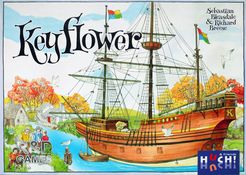
Designers: Sebastian Bleasdale, Richard Breese
Artists: Juliet Breese, Jo Breese, Gemma Tegelaers
Here is another game that I haven’t played, though I played it a few times on Boardgame Arena.
And it just reinforces the concept that I need to play a game on the table before I can really understand it, because this one really didn’t make much sense to me that way.
Which is not necessarily a bad thing.
I’d love to play it on the table and see what all the fuss is about.
Let’s blurb this because it would make way more sense that I could make of it.
“Keyflower is a game for two to six players played over four rounds. Each round represents a season: spring, summer, autumn, and finally winter. Each player starts the game with a “home” tile and an initial team of eight workers, each of which is colored red, yellow, or blue. Workers of matching colors are used by the players to bid for tiles to add to their villages. Matching workers may alternatively be used to generate resources, skills and additional workers, not only from the player’s own tiles, but also from the tiles in the other players’ villages and from the new tiles being auctioned.
In spring, summer and autumn, more workers will arrive on board the Keyflower and her sister boats, with some of these workers possessing skills in the working of the key resources of iron, stone and wood. In each of these seasons, village tiles are set out at random for auction. In the winter no new workers arrive and the players select the village tiles for auction from those they received at the beginning of the game. Each winter village tile offers VPs for certain combinations of resources, skills and workers. The player whose village and workers generate the most VPs wins the game.”
The concept sounds really interesting, and I know a lot of people who are Breese fans, so I’m sure this one is good.
I just haven’t had the chance to play it yet. The only time it ever came out when I was around, it already had a full player count and I was going to head out for dinner at the convention I was at.
I’ve been intrigued by my BGA plays, enough so that I really want to try this one.
#52 – Fields of Arle (Z-Man Games) – 2014
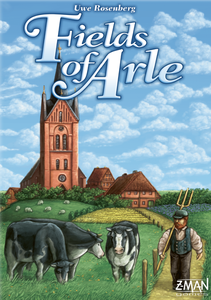
Designer: Uwe Rosenberg
Artist: Dennis Lohausen
A two-player farming game by Uwe where again you have to feed your people, but this strikes me as maybe not as punishing as some of his other games.
In this one, one or two players are living during a prosperous time and just trying to have a successful farm.
I haven’t played this one for a few reasons, though namely because it’s 2-player and my ability to get more complex and longer 2-player games to the table is almost non-existent. I haven’t sought it out for just that reason.
However, it looks like a typical Uwe with farming stuff and trying to optimize what you produce and what you sell so that you are the most prosperous farmer out there. But it’s not just farming. You can produce goods, clear fields and harvest resources to capitalize on the abundance around you.
And there is a lot of abundance.
Are we sure this is an Uwe game?
Anyway, let’s do a little blurb just so you can understand a bit about the game.
“Work the Land
Whether you delve into flax farming or leverage other areas of expertise, always make sure that you have the land to build up your village. Construct dikes to keep the waters at bay and expand your fields. Dry out bogs to harvest peat and then clear the land for cultivation. Create more fields for your livestock, buildings, or future crops; after that, you can decide whether to house animals or cultivate a forest for timber. Perhaps you’d like to take up some flax farming for yourself, or diversify and try out a little bit of everything.”
It’s cool that this is limited to 2 players. I almost did buy this one time but apparently the sale price on Amazon was actually too good to be true and all of the orders were cancelled.
Too bad.
It probably still wouldn’t have gotten played, but I could say that I have it at least!
I wouldn’t be against trying this one to see if I like it better than Uwe’s other classics that I don’t really care for.
I’m open-minded that way.
#51 – Race for the Galaxy (Rio Grande Games) – 2007
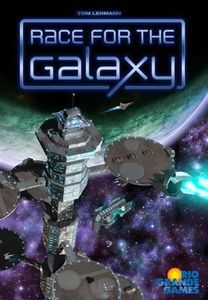
Designer: Thomas Lehmann
Artist: Martin Hoffmann, Claus Stephan, Mirko Suzuki
Finally this week we get to that card game where everybody says “that looks fun, but the symbology just confuses me!”
Ok, maybe that’s just me? I don’t know.
Anyway, Race for the Galaxy is a space card game that’s kind of based on Puerto Rico (the history with this one, that one, and San Juan just kind of confuses me).
The game is a tableau-builder where you are playing cards from your hand and paying for them with other cards in your hand.
That’s right, cards are multi-purpose in this game. They can cards you play, cards you spend, or they can actually be goods that are placed on planets.

I have only played this on the table once, seven years ago (hence no pics), but I’ve played dozens of times on the app and the app is amazing.
After playing the app, I finally understand it!
I’m not good at it, but I understand it!
Cards you play in front of you are worth points but you can also “consume” goods from planets in the proper phase to get victory point chits as well.
These cards also give you abilities in certain phases (just like Roll for the Galaxy, the dice version of this one). Each player chooses one (or two if you’re playing a certain version of 2-player) phase that they want to activate this turn. Only those phases actually happen on the turn, so sometimes you have to hope somebody else will choose that phase that you kind of want because this other phase is more important.
While I really enjoy the app version of this game, I’m not sure how excited I would be to play it on the table again. The app takes care of a lot of the bookkeeping that may drag the card game itself down.
I’d have to try it again just to see.
Which I would be willing to do, even if I wouldn’t be excited about it.
But the app is amazing! Go download it now.
And there we have it.
Halfway through the BGG Top 100 and I’ve played 21 of the games. That’s on pace for the 40 that I predicted!
This week I’ve played 6 of them, with one on Boardgame Arena and one in app form many moons ago.
I think that’s the best week yet!
What do you think of all these games? Any recommendations? Do you hate any of them?
Or are you indifferent enough that you wonder why you even clicked on this to begin with?
If that last one, I hope you stick around!
There are cookies.
Anyway, let me know in the comments what you think!
Posts in this Series:
#100-91
#90-81
#80-71
#70-61
#60-51
#50-41
#40-31
#30-21
#20-11
#10-1
If I were titling this segment of the countdown, I’d call it, “A Bunch of Games I Want to Like More Than I Do.” A terrible title, though accurate. But this is why you have a blog and I do not : )
From this list, Lords of Waterdeep is the only one I really like (and I do really like it, although I like the app more than the physical at this point). Caylus and Dominant Species are sort of brutal (though in different ways), Clank feels a little random and luck-based for me, and yes, the Race for the Galaxy symbology never clicked for me (I know, I need to just get the app already). Nor did Keyflower’s actually, on my one and only play of that. I’m sure there’s a great game under there, but I never quite got it.
The rest I have not played. I do want to try Fields of Arle–I’ve been after that one in the BGG math trades for a while, but it doesn’t come up often.
Enjoying this great series, Dave!
LikeLiked by 1 person
I’m glad you’re liking it! This one had a number of games I like but yeah, some are better than others. I do remember how brutal Dominant Species is. LOL You haven’t tried Clank in Space, right? I’d be interested in your thoughts on that if you have.
I really appreciate your regular comments on these posts. It does make me feel like Jeremy Renner in that gif when i see these comments. 🙂
LikeLike
I have not tried Clank in Space, you are right, but it’s been on my list since your review of it! I think even if I picked it up today, though, it would be a while before I got to play it with my group given the current situation.
LikeLiked by 1 person
Yeah, I totally get that. Would be interesting to hear what you think of it given your talking about the randomness of the original Clank.
LikeLike
Now, finally some good score for me – 5/10 (Clank, Caylus, Five Tribes, Dominant Species, Race for Galaxy). Thanks for those articles, I really enjoy them!
LikeLiked by 1 person
I’m glad you’re enjoying! What do you think of Caylus and Dominant Species?
LikeLike
I played Caylus only once. I remember this game as one with elegant mechanics, nothing too modern, very nicely balanced. On the other side, I played Dominant Species umpteen times and treat is as most brutal and merciless game eve played – nicely disguised being animals and wooden blocks. My wife who does not like Wargames, has no objection to obliterate swaths of species in that title 🙂 I like it very much!
LikeLiked by 1 person
Pingback: Boardgame Geek Top 100 – Played or Play? 70-61 – Dude! Take Your Turn!
Pingback: Boardgame Geek Top 100 – Played or Play? 80-71 – Dude! Take Your Turn!
Pingback: Boardgame Geek Top 100 – Played or Play? 90-81 – Dude! Take Your Turn!
Pingback: Boardgame Geek Top 100 – Played or Play? 100-91 – Dude! Take Your Turn!
Pingback: Boardgame Geek Top 100 – Played or Play? 50-41 – Dude! Take Your Turn!
Pingback: Boardgame Geek Top 100 – Played or Play? #40-31 – Dude! Take Your Turn!
Pingback: Boardgame Geek Top 100 – Played or Play? #30-21 – Dude! Take Your Turn!
Pingback: Boardgame Geek Top 100 – Played or Play #20-11 – Dude! Take Your Turn!
Pingback: Boardgame Geek Top 100 – Play or Played – #10-1 – Dude! Take Your Turn!